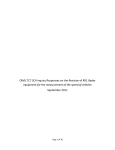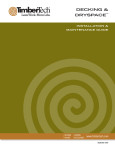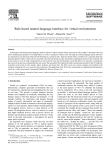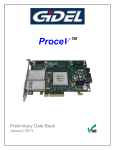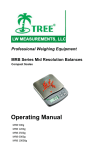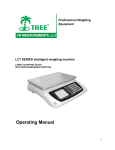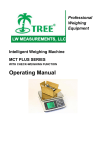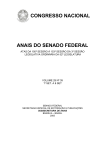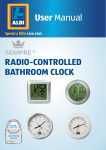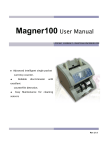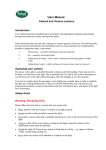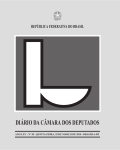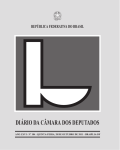Download Calibration guide for the UNIPAR SL 700 Laser Speed
Transcript
A Guide to Calibration Requirements for Traffic Enforcement Equipment Covering Speedmeters, Traffic Light Cameras, and Bus Lane Enforcement Cameras Type-Approved for Road Traffic Law Enforcement in Great Britain. Dr J F Miller Publication No. 18/98 POLICE SCIENTIFIC DEVELOPMENT BRANCH HOME OFFICE POLICE POLICY DIRECTORATE A GUIDE TO CALIBRATION REQUIREMENTS FOR TRAFFIC ENFORCEMENT EQUIPMENT Dr J F MILLER FIRST PUBLISHED 1998 The text of this publication may not be reproduced, nor may talks or lectures based on material contained within the document be given, without the written consent of the Director, Home Office Police Scientific Development Branch. Published by: Home Office Police Scientific Development Branch Woodcock Hill Sandridge, St Albans Hertfordshire AL4 9HQ United Kingdom PSDB 18/98 Management Summary This document provides guidance on Home Office requirements for the calibration of traffic enforcement equipment which has been type-approved by the Home Office. Existing handbooks published by PSDB describe the procedures and requirements to be met to obtain type-approval for speedmeters, traffic light cameras, and bus lane cameras. These require type-approved devices to be calibrated annually, and this document lays down the minimum requirements for these calibration procedures. As well as the types of tests required for each device, this handbook also elaborates on the requirements for documentation and certification of the calibration process. PSDB 18/98 i ii PSDB 18/98 Page 1 INTRODUCTION................................................................................................................................ 1 2 GENERAL REQUIREMENTS FOR ALL DEVICES............................................................................ 1 3 ADDITIONAL REQUIREMENTS FOR AUTOMATIC EQUIPMENT ................................................... 2 3.1 Tests .................................................................................................................................................. 2 3.2 Documentation ................................................................................................................................... 2 4 REQUIREMENTS FOR RADARS...................................................................................................... 3 4.1 Tests .................................................................................................................................................. 3 4.2 Documentation ................................................................................................................................... 3 5 REQUIREMENTS FOR HAND-HELD OPTICAL DEVICES ............................................................... 3 5.1 Tests .................................................................................................................................................. 3 5.2 Documentation ................................................................................................................................... 4 6 REQUIREMENTS FOR PRESSURE SENSOR & ACROSS-THE-ROAD OPTICAL DEVICES......... 4 6.1 Tests .................................................................................................................................................. 4 6.2 Documentation ................................................................................................................................... 4 7 REQUIREMENTS FOR TRAFFIC LIGHT CAMERAS ....................................................................... 4 7.1 Tests .................................................................................................................................................. 4 7.2 Documentation ................................................................................................................................... 5 8 REQUIREMENTS FOR BUS LANE ENFORCEMENT CAMERAS.................................................... 5 8.1 Tests .................................................................................................................................................. 5 8.2 Documentation ................................................................................................................................... 6 PSDB 18/98 iii 1 INTRODUCTION Any traffic enforcement equipment which has been type-approved by the Home Office will have been satisfactorily tested against the specifications and requirements listed in the appropriate handbooks published by PSDB. These are subject to updating, but the current list of relevant handbooks at the time of writing are: • The Speedmeter Handbook (Third Edition) Provisional - Publication No. 13/97; • The Bus Lane Enforcement Camera Handbook Provisional - Publication No. 17/96; • Automatic Distance/Time Speedmeter Handbook - Publication No. 8/95, and; • The Traffic Light Camera Handbook - April 1992. One of the requirements of Home Office type-approval is the need annually to calibrate type-approved devices, and for the records of such calibration to be open to inspection by the Home Office. There is some variation in the procedures and documentation currently used in the annual calibration of police traffic enforcement equipment. While it is not felt necessary to prescribe in full detail what procedures should be used and documentation produced, further guidance follows in order to set minimum standards which should be followed. Generic requirements for all devices are given in the next section. Subsequently, additional requirements for automatic equipment are given, to provide confirmation of the integrity of evidence in the recorded information and secondary check. Automatic equipment is defined in The Speedmeter Handbook as: “A speedmeter, which once set up, works by itself without direct and continuing human intervention and operates with an approved secondary check.”. This applies to both “automatic unattended”, and “automatic supervised” equipment. Finally, for each type of device, additional minimum calibration requirements specific to each are covered. These requirements may be updated and supplemented by PSDB and further editions published in the future. 2 GENERAL REQUIREMENTS FOR ALL DEVICES 2.1 The complete calibration process shall be carried out annually. Any maintenance work on a device should be followed by functional checks to determine whether the calibration of the device remains valid. If not, the complete calibration procedure shall be undertaken. 2.2 Adequate test equipment and facilities shall be available to the person carrying out the calibration procedure. All equipment used for calibration shall be certified annually by a competent body with equipment traceable to national standards. 2.3 Prior to calibration of the enforcement device, the calibration records of the test equipment to be used shall be checked to ensure they have been tested within the last year with equipment traceable to national standards. PSDB 18/98 1 2.4 A calibration certificate shall be supplied to the police force using the device, with a copy held on record by the person who has calibrated the device. In addition to device specific requirements listed later in this document, the calibration certificate shall include: i) the name of the individual who undertook the calibration, and his or her company; ii) the device manufacturer, type/model and serial number; iii) the date on which the calibration was conducted; iv) a certificate number and the date issued; v) a statement to the effect that any parts or components replaced are identical to those used in the device as type-approved; and vi) the signature of the person who undertook the calibration. 2.5 Any continuation sheets shall also be clearly marked with the certificate number, date, and device serial number. 2.6 The calibrator shall keep on record with a copy of the certificate, a log of all calibration measurements obtained and any observations made, marked with the same certificate number, date and device serial number. This log shall be made available for inspection by the Home Office. 2.7 The calibrated equipment should be marked with an adhesive label stating; the date of calibration, the date on which the next calibration is required, along with the signature of the person who carried out the calibration. 3 ADDITIONAL REQUIREMENTS FOR AUTOMATIC EQUIPMENT 3.1 Tests 3.1.1 All in-built test routines shall be run and the results recorded. 3.1.2 If there is a flash unit or other means of illumination this shall be visually inspected. The flash button and actual operation of the flash shall be checked. 3.1.4 The timing of the secondary check shall be measured. This may be achieved, for example, by using a free running millisecond counter confirming that the time difference displayed in the secondary check evidence is within the tolerance set by the manufacturer. At least 3 measurements shall be taken at both the minimum and maximum possible delay times. These shall be recorded. 3.1.5 All bulbs, buttons, switches, plugs, and connectors on any recording equipment are to be checked for proper operation. 3.2 Documentation 2 PSDB 18/98 3.2.1 If, and only if, the device passes all of the tests specified in 3.1 then a calibration certificate shall be produced in accordance with 2.4. 3.2.2 In addition a statement verifying that the timing of the secondary check is within the manufacturer’s tolerance shall appear on the calibration certificate. 4 REQUIREMENTS FOR RADARS 4.1 Tests 4.1.1 All in-built test routines shall be implemented, and the results recorded. 4.1.2 The operating frequency of the radar shall be measured and recorded. It shall be within the operating range specified by the manufacturer. 4.1.3 A minimum of five speeds shall be simulated covering a speed range of at least 20 mph to 80 mph. All simulated and measured speeds observed shall be recorded. To pass, all shall agree to within ± 1 mph. 4.1.4 If a tuning fork is used for checking the correct operation of the radar, then it’s frequency shall be measured and recorded. The speed produced on the radar using the tuning fork shall be measured and shall be within ± 1 mph of its specified simulation speed. 4.2 Documentation 4.2.1 If, and only if, the radar passes all of the tests specified in 4.1, a calibration certificate shall be produced in accordance with 2.4, and 3.2 if applicable. 4.2.2 In addition the following information shall appear on the calibration certificate: i) the specified and measured operating frequency of the radar; ii) the serial number of the tuning fork, if used; iii) the specified and measured frequency of the tuning fork; and iv) a table of simulated speeds and corresponding measured speeds. 5 REQUIREMENTS FOR HAND HELD OPTICAL DEVICES This section refers to optical devices which calculate speed from a series of range measurements 5.1 Tests 5.1.1 All in-built test routines shall be run, and the results recorded. PSDB 18/98 3 5.1.2 The pulse repetition frequency (PRF) shall be measured either externally to the device, or by internal measurement of the appropriate quartz clock. It shall be within the operating range specified by the manufacturer. 5.1.3 The horizontal and vertical alignment of the laser beam with the sight shall be checked using the method recommended in the device user manual. 5.1.4 If a simulator is available, a minimum of five speeds shall be simulated covering a speed range of at least 20 mph to 80 mph. All simulated and measured speeds observed shall be recorded. To pass, all shall agree to within ± 1 mph. Alternatively, the device shall be checked functionally against another type-approved speed measuring device which can be calibrated by simulation. At least 5 speeds shall be measured and compared, covering a speed range of at least 20 mph to 80 mph. To pass, these should agree to within the combined tolerances stated by the manufacturers. 5.1.5 The device shall be used to make at least 3 different range measurements against 3 accurately measured distances of between 25 and 100 metres to a reflective target. These distances, as well as the speed readings if present (which should always be 0 mph when measuring a fixed target) shall be recorded throughout this test. To pass, they shall all be within the manufacturer’s stated tolerance. 5.2 Documentation 5.2.1 If, and only if, the device passes all of the tests specified in 5.1, a calibration certificate shall be produced in accordance with 2.4 and 3.2 if applicable. 5.2.2 In addition the following information shall appear on the calibration certificate: i) the pulse repetition frequency or appropriate clock frequency shall be listed against the expected value; ii) a statement verifying that the alignment is correct; iii) a table of simulated speeds or speeds measured from another type-approved device, and corresponding measured speeds; and iv) a table of actual and corresponding measured range. If presented, the corresponding speed readings shall also be listed, or a statement verifying they were all 0 mph, given. 6 REQUIREMENTS FOR PRESSURE SENSOR & ACROSS-THEROAD OPTICAL DEVICES 6.1 Tests 6.1.1 All in-built test routines shall be run and the results recorded. 6.1.2 A minimum of five speeds shall be simulated covering a speed range of at least 20 mph to 80 mph. All simulated and measured speeds observed shall be recorded. To pass, all shall agree to within ± 1 mph. 4 PSDB 18/98 6.2 Documentation 6.2.1 If, and only if, the device passes all of the tests specified in 6.1 then a calibration certificate shall be produced in accordance with 2.4 and 3.2 if applicable. 6.2.2 In addition, a table of simulated and corresponding measured speeds shall appear on the calibration certificate. 7 REQUIREMENTS FOR TRAFFIC LIGHT CAMERAS 7.1 Tests 7.1.1 All in-built test routines shall be run and the results recorded. 7.1.2 The flash unit shall be visually inspected. The flash button and actual operation of the flash shall be checked. 7.1.3 The operation of the loop detector shall be monitored by passing a metal object over a simulated loop set-up. This operation shall also be checked with the flash firing with the traffic light on red. These results shall be recorded. 7.1.4 Camera timing shall be measured. This may be achieved by using a free running millisecond counter confirming that the time difference displayed in the two pictures is within the tolerance set by the manufacturer. At least 3 measurements shall be taken at both the minimum and maximum possible delay times. These shall be recorded. 7.1.5 All bulbs, buttons, switches, plugs, and connectors are to be checked for proper operation. 7.1.6 If the device outputs a speed value, a series of speed measurement tests shall be carried out using a speed simulator at the loop spacing typically used for the device operationally. A minimum of five speeds shall be simulated covering a speed range of at least 20 mph to 80 mph. To pass, all shall agree to within ± 1 mph. 7.1.7 Any LED displays shall be checked for correct operation. 7.1.8 When a correct signal sequence is applied, activation of the loop detector shall be simulated at 1.0, 1.6, and 2.0 seconds after the red signal with an activation threshold set at 1.5 seconds. For each condition a record shall be made of whether the system was activated, and when activated, what the indicated time into red was. To pass, no activation shall occur in the 1.0 second test, and the indicated times into red shall be within the tolerance set by the manufacturer. 7.2 Documentation 7.2.1 If, and only if, the device passes all of the tests specified in 7.1 then a calibration certificate shall be produced in accordance with 2.4. 7.2.2 In addition the following information shall appear on the calibration certificate: PSDB 18/98 5 i) a table of simulated speeds and corresponding measured speeds, and; ii) a table of simulated time into red and corresponding indicated time into red, and a statement verifying the system only activated above the set threshold. 8 REQUIREMENTS FOR BUS LANE ENFORCEMENT CAMERAS 8.1 Tests 8.1.1 All in-built test routines shall be run, and the results recorded. 8.1.2 Correct operation of the equipment shall be checked by simulation on-site or a road test of the equipment to: i) record a sequence of at least two recordings; ii) interrupt a recording with a door alarm, and ensure that an authorised access cancels the effect of that door alarm; iii) confirm that clock settings are within 10 seconds of the Rugby source; and iv) ensure that the timer responsible for maintaining the enforceable time limits is capable of switching on and off at pre-set times. The test recording shall be checked for accuracy and completeness of the information recorded against the manufacturer’s specification. 8.2 Documentation 8.2.1 If, and only if, the device passes all of the tests specified in 8.1 then a calibration certificate shall be produced in accordance with 2.4. 6 PSDB 18/98












